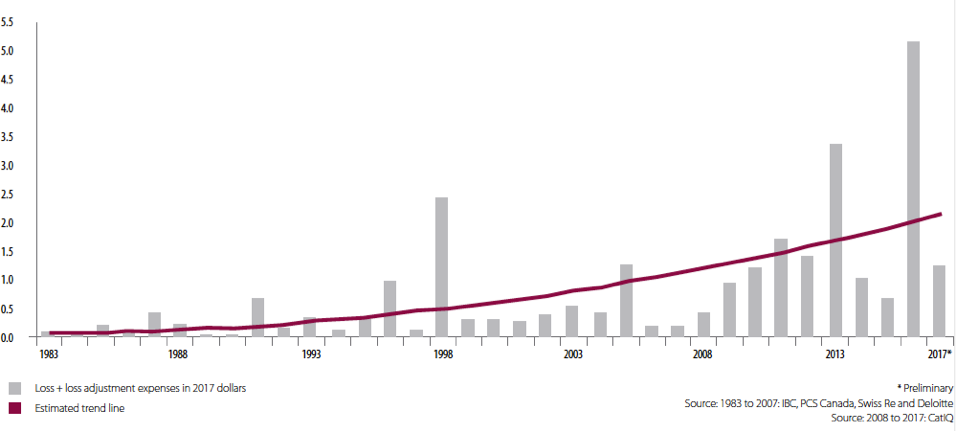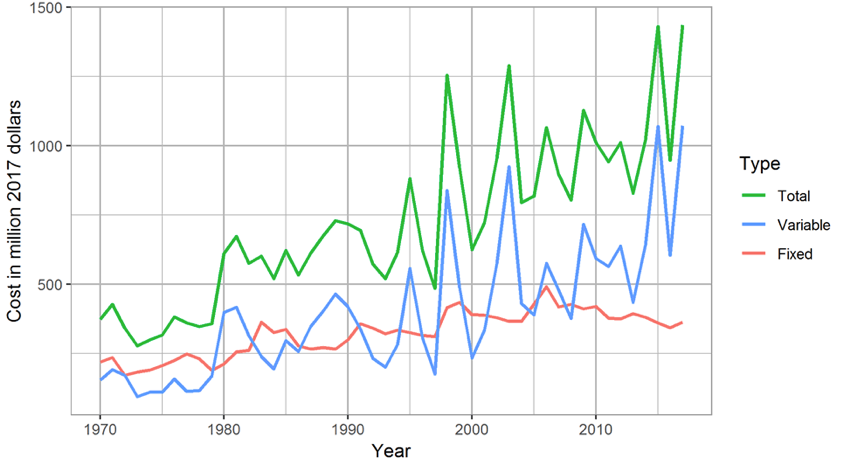Canadian wildfires: are we prepared for the next disaster?
Author(s):
Adeniyi Asiyanbi
Conny Davidsen

While the world grapples with the evolving impacts of COVID-19, the Canadian wildfire season is here again.
As the record-setting Australian wildfire season of 2019/2020 (1) and California’s 2018 wildfires (2) remind us, disastrous and costly wildfires are becoming more frequent. Canada’s 2016 Horse River wildfire (3) in Fort McMurray led to the evacuation of 88,000 people, destroyed about 2,000 structures and damaged many more, becoming the costliest natural disaster in Canadian history for insurers. It tallied up to an insured property damage of about CAD $3.6 billion, continuing a trend of growing disaster cost in Canada (see figure 1).

Figure 1: Catastrophic losses in Canada in billion Canadian Dollars 1983 to 2017 and trend
Source: Insurance Bureau of Canada (IBC) Fact Sheet (4).
For Canada, climate change-related projections (5) have found shifting wildfire patterns through impacts on temperature, lightning, precipitation and fuel moisture, suggesting increasing wildfire ignition probability and alarming changes to wildfire behaviour overall. Wildfire occurrence across Canada could increase by up to 140% by 2100 (6), and the frequency of extreme days with potentially unmanageable fires may increase across Canada even by 400% by 2050 (7).
Our on-going research draws attention to the centrality of public policy strategies in wildfire preparedness in Canada, especially in three areas: Public investment, public engagement, and climate action.
Public Investment
Canada’s wildland fire protection cost is escalating, and fast. Years 2015 and 2017 saw record high wildfire protection expenditures of about CAD$ 1.4 billion, just as federal annual spending on natural disaster relief (8) in general reached an historic peak of CAD$1.4 billion in 2013. Indeed, a recent study estimated (9) that the annual cost of extreme weather events in Canada may rise to CAD$ 43 billion by 2050. Another study (10) estimated that extreme fire suppression costs will become more frequent, occurring every two years or even more often across Canada – up from once in a decade.
Yet, balancing investment in long-term wildfire planning and prevention programmes with wildfire suppression and recovery cost has been inconsistent.
As a ground rule, long-term and proactive investment in wildfire planning and management seems to pay off. Public Safety Canada (2019) (11) found that every $1 invested in long-term programmes has saved, on average, about $6 of cost during the response and recovery phase.
However, as studies show (12), long-term investment in programmes and fire prevention has continued to decline, while expenditure on suppression and recovery continued to rise (see figure 2). This limits long-term preventive wildfire research and programmes, at a time when these efforts are most needed. The situation is exacerbated as a significant cohort of senior experts is beginning to retire (13) from service, requiring even more training investment for new cohorts.

Figure 2. The cost of wildland fire protection in Canada from 1970 to 2017 (in million 2017 Canadian Dollars)
Source: NRCan, 2019 (14).
Public Engagement
Canada’s Wildland Fire Strategy (15) highlights a focus on public engagement across Canadian provinces, with four strategic objectives: public education/awareness and policy/risk analysis; preparedness and response capability; innovation; and the Canadian FireSmart initiative.
FireSmart (16/a>) has become a flagship national programme for local communities and land owners to reduce wildfire damage. Though full of potential, the initiative has only achieved limited participation among the vast majority of communities across Canada. The Legislative Audit Offices (17) warned in 2019 that many provinces and territories still have no in-depth adaptation plans developed, leaving hundreds of communities with no preparation or planning for their forecasted risks.
And FireSmart also faces considerable challenges. It remains the most underfunded of the four strategic objectives (15/a>) of the Canadian Wildland Fire Strategy. About CAD$ 214 million were invested in FireSmart across Canada between 2005 and 2015, representing only 24% of the projected need of the programme, as the 10-year review of the Canadian Wildland Fire Strategy (13) notes. Compared to recent cost averages for annual fire suppression around CAD$ 1 billion, sustained investment in public engagement through initiatives like FireSmart appears inadequate.
Climate Action
If climate change has been shown to create conditions (5) that exacerbate wildfire problems, wildfires in turn contribute to climate change by releasing carbon emissions from tree biomass, among other processes. Though Canada’s forests are considered a net carbon sink, wildfires are about the most significant factor determining their hugely varying levels of carbon emission (18).
Yet, Canadian forest and wildfire management is yet to significantly integrate emission reduction opportunities, even if this comes with recognizing various limits. Instead, forest-based carbon emissions have been relatively underemphasized, except for some forest carbon-enhancing initiatives within the Pan-Canadian Framework (19) with varying levels of support across the provinces and territories. A recent report (17) of the Canadian Auditors General identified this as part of a general lukewarm attitude towards climate change mitigation and adaptation across most governments in Canada.
The immediate dangers of wildfires command significant media and policy attention, and rightly so. However, ignoring the broader links of wildfire to climate change (20) downplays the increasing wildfire risks we face in Canada, and denies us opportunities to prepare for the projected future of growing wildfire complexity.
For instance, this is partly why some areas in Western Canada which are projected to experience some of the most serious wildfire pattern changes exacerbated by climate change (e.g. increase in fire spread days (21) and increase in area burned (22)) ironically have the least proportion of people (23) who believe that climate change will harm them personally.
Effective Canadian wildfire preparedness policies will have to carefully ‘connect the dots’ between wildfires and climate change, and mobilize public investment – in funding and in action – in preparing for future disasters. Wildfire disasters are increasingly not a question of if, but when.
(1) https://theconversation.com/with-costs-approaching-100-billion-the-fires-are-australias-costliest-natural-disaster-129433
(2) https://www.fire.ca.gov/media/5511/top20_destruction.pdf
(3) https://www.rmwb.ca/Assets/Lessons+Learned+$!26+Recommendations+2016+Horse+River+Wildfire.pdf
(4) http://assets.ibc.ca/Documents/Facts%20Book/Facts_Book/2018/IBC-Fact-Book-2018.pdf
(5) https://www.nrcresearchpress.com/doi/full/10.1139/er-2013-0042#.XjXevtNrKRs
(6) https://www.publish.csiro.au/wf/wf09002
(7) https://link.springer.com/article/10.1007/s10584-015-1375-5
(8) http://www.ibc.ca/ab/resources/media-centre/media-releases/severe-weather-natural-disasters-cause-record-year-for-insurable-damage-in-canada
(9) http://ok-cear.sites.olt.ubc.ca/files/2019/06/Local-Adaptation-in-Canada-Full-web.-1.pdf
(10) https://cfs.nrcan.gc.ca/publications?id=37133
(11) https://www.publicsafety.gc.ca/cnt/rsrcs/pblctns/mrgncy-mngmnt-strtgy/mrgncy-mngmnt-strtgy-en.pdf
(12) https://www.sciencedirect.com/science/article/pii/S2590061719300456
(13) https://cfs.nrcan.gc.ca/publications?id=37108
(14) https://www.nrcan.gc.ca/climate-change/impacts-adaptations/climate-change-impacts-forests/forest-change-indicators/cost-fire-protection/17783
(15) https://www.ccfm.org/english/coreproducts-wildlandfires.asp
(16) https://firesmartcanada.ca/
(17) https://www.oag-bvg.gc.ca/internet/English/parl_otp_201803_e_42883.html
(18) https://www.nrcresearchpress.com/doi/full/10.1139/cjfr-2018-0176#.XkdHPdNrKRs
(19) https://www.canada.ca/en/services/environment/weather/climatechange/pan-canadian-framework.html
(20) https://link.springer.com/article/10.1007%2Fs10584-019-02378-w
(21) https://iopscience.iop.org/article/10.1088/1748-9326/aa5835
(22) https://onlinelibrary.wiley.com/doi/full/10.1111/j.1365-2486.2008.01679.x?casa_token=VBwVGeG9fbgAAAAA%3AsT06alJC3XCkAAWIbys-K8K4YON6QWq40-EWtKDcf5R2aZDxnqPywFOVXaXbfzZ33UoZoynyTTm9ivk-
(23) https://www.umontreal.ca/climat/engl/index.html
More on the Author(s)
Adeniyi Asiyanbi
Department of Geography, University of Calgary
SSHRC Postdoctoral Fellow
Conny Davidsen
Department of Geography, University of Calgary
Associate Professor

